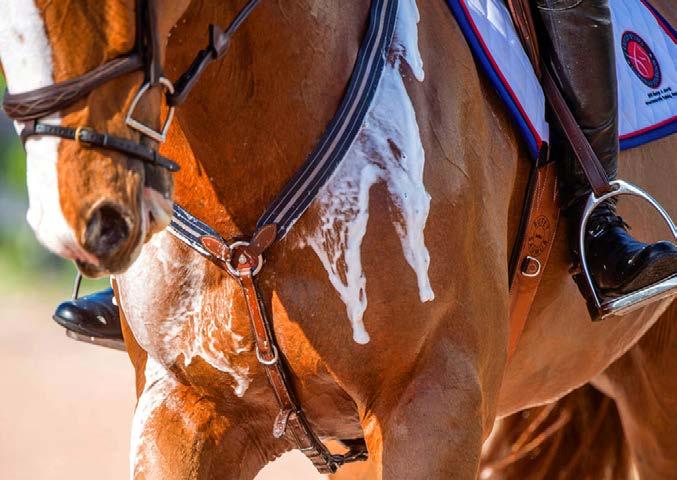
9 minute read
Nutrition: Summer Feeding
The nutrient content of grasses change during summer. BELOW RIGHT: Carbohydrate-rich oats might overheat your horse during summer.
NUTRITION
Advertisement
Feeding for summer
As with all times of year, what you feed your horse in summer depends on factors such as their level of work, age and size. However, feeding horses over summer comes with some unique challenges, writes LEISA HOFSTETTER.
The increased ambient temperatures associated with the summer months can affect a whole range of factors associated with feeding your horse the right feed. But it’s not only the temperature that changes over summer. The nutrient content of grasses and other forages change during this time too!
Increased ambient temperatures in summer may affect what you should feed your horse. Aspects of your horse’s feed that might need to be modified include electrolytes, the type of energy source, and water intake.
Electrolytes Electrolyte levels in your horse’s feed may need to be different in summer because an increase in ambient
temperature means your horse will sweat more than in the cooler months. Because electrolytes are lost in sweat, the more your horse sweats, the more electrolytes you will have to add to their feed. Be careful not to oversupply electrolytes though, as this can have the opposite effect to the one you are trying to achieve. Fats vs carbs When horses digest their food, a lot of the energy is lost as heat. This generated heat can be a potential problem in summer for horses performing moderate to high intensity work, such as race horses and show jumpers, as they can overheat. Theoretically, a diet with a reasonably high fat content will generate less heat in digestion than a diet with the same amount of energy supplied by carbohydrates. It may therefore be useful for horses in competitive work over summer to increase the fat content in their ration and lower their carbohydrates. The opposite may be true in winter. If your horse needs to generate heat to keep warm, their body will consume energy to do so. It may be more efficient to feed more carbohydrates and less fat in the cooler months because heat generation is more efficiently sourced from carbohydrates than fats. However, roughage in forages such as fresh grass and hay should still make up the majority of a horse’s diet, no matter what the time of year.

But what about protein? Protein is quite an inefficient source of energy. Proteins are made up of chemical building blocks called amino acids, which are vital for a lot of different body functions in both horses and humans, so it shouldn’t be disregarded in a horse’s diet. But if you are aiming to get the most out of energy supply, protein is not the way to go.
When protein is converted to usable energy in the horse’s body, a lot of heat is produced for a small amount of energy in comparison to carbohydrates or fats. So protein is another energy source that could present a problem if fed in excess in the hotter ambient temperatures of summer, especially for horses in heavy work over long periods of time, like endurance horses. Horses overheating can be just as detrimental as it can be for humans, and can even be fatal if not treated quickly. But the most likely side effect of too much protein can be excess sweating, which as you read earlier, comes with its own host of problems due to electrolyte loss.
SCHOLARSHIP

The Delivering Dreams Scholarship

We received some exceptional applications for this year’s Delivering Dreams Scholarship. Selecting a recipient proved difficult, so much so that our judges have chosen two particularly outstanding applicants: Jamie Hocking and Luke Purtill.

The HorseVibes Delivering Dreams Scholarship is something of which I am extremely proud. It has been a long-held dream of mine to help equestrians of all ages and abilities move closer to their own dreams. And that’s exactly what the scholarship is designed to do: to motivate its recipients and assist them in removing any barriers that might be holding them back.
This particular scholarship round has been outstanding. We introduce Jamie and Luke to you on the following pages, along with our nine wonderful finalists. And I would like to personally thank everyone who has made it so very special, our applicants, our very generous sponsors, our panel of expert judges, my family, and my many friends, all of whom have helped in so many ways.
With much gratitude,





Delivering Dreams Scholarship Sponsors



Forages Forages such as grass and hay should make up the majority of your horse’s diet, at all times of the year. There are actually some variations in types of grasses that may affect what you feed your horse in the remainder of their diet. There are two main types of grasses, cool season and warm season. The differences in cool versus warm season grasses can be quite distinctive. Some obvious differences include the types of sugars present in the grasses and the presence or absence of calcium compounds called oxalates. In sub-tropical climates such as the Far North Coast of NSW, warm season grasses are prevalent.
Warm season grasses are those species of grasses that grow to maturity and produce seeds in the warm seasons of the year. The opposite is true of cool season grasses. Often warm season grasses are high in oxalates. Oxalates are compounds that bind calcium in the digestive system of the horse and prevent it from being absorbed into the body. This can cause a deficiency so severe that calcium will be taken from the bones to compensate for the lack of calcium available for important bodily functions. A calcium deficiency can sometimes be visually obvious, such as ABOVE: Forages such as grass and hay should make up the majority of your horse’s diet, at all times of the year. BELOW: Electrolytes lost when your horse sweats should be replaced by adding them to their feed.

with the symptoms of big head disease. Warm season grasses But what does this have to do with summer? New growth of warm season grasses containing oxalates tend to have a higher oxalate content than the same grasses in later stages of maturity. So this means that in spring, during the beginning of the growth stages, the oxalate content in warm season grasses will be higher than in summer, when the grasses are more mature. But because of these growth stages, there may even be variations in oxalate content in warm season grasses within the summer months, with more oxalates being present in early summer than later in the season.

There is another factor to consider when looking at the maturity stage of grasses. You might have observed that your horse prefers new growth grass to tall, well developed grass that is ready to produce seeds. For horses, the palatability of new grass certainly seems much greater than for mature grasses. In addition to palatability, digestibility also decreases as grasses become more
EQUESTRIAN HUB DIRECTORY: Buy an annual platinum membership for your friend and you'll get one too!
Visit: directory.equestrianhub.com.au | Email us at directory@equestrianhub.com.au

Photo GRC Photography Sterling Essentials tack cleaner and conditioner are the best products on the market. They are quick and easy to use, come in wonderful fragrances, and ensure the longevity of your tack. After long trot sets in the rain, the conditioner helps rejuvenate dry leather. After a sweaty jump school, the cleaner gets rid of dirt and sweat efficiently. I can't say enough good things about these products, and about Sterling Essentials' commitment to getting it right.



mature. This is because mature grasses contain more structural carbohydrates such as cellulose, hemicellulose and lignin than new grass. Digestibility Lignin is a nitrogen containing compound that helps to give grass stems their rigid structure. Cellulose and hemicellulose also play a role in the structural component of grasses, but where cellulose and hemicellulose are digestible in the horse, lignin is not. Humans cannot digest any of these structural carbohydrates, which are often referred to as fibre. It is only because of certain microflora in the hindgut of a horse’s digestive tract that they get any nutrients from cellulose and hemicellulose at all. These microbes are able to do the digesting for the horse.
As digestibility decreases in more mature grasses, so does the energy the horse is able to absorb from the grass. This means warm season grasses in spring and early summer will give the horse more energy than those same grasses in late summer. This also has implications for horses at risk of laminitis, in that there are more starches and sugars in early stage growth of warm season grasses than mature warm season grasses. Starches and sugars affect insulin levels, which can affect laminitic horses or those at risk of laminitis.
Factors to consider Feeding horses in summer comes with a range of unique challenges. Ambient temperature and seasonal growth of pastures can affect what you should feed your horse, and it’s important to consider all the factors affecting each individual horse. Your Equine Nutritionist can help to ensure that you’re feeding your horse correctly, no matter the season.
Leisa Hofstetter, BEqSc, is an Equine Nutritionist and founder of Hof Equine. Call her on 0415 120 454, email hofequine@gmail.com, or visit www.facebook.com/HofEquine
Dressage Saddles
equestrianhub.com.au


Devoucoux Makila S 17.5" $4,750

Peter Horobin SF Geneva 17.5" $4,995
Kieffer Paris Exclusiv Size 1 $2,500


